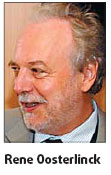China and Europe are looking to broaden their space partnership under which the European Space Agency (ESA) is currently collaborating on the Chang'e-1 project.
Rene Oosterlinck, ESA director of legal and external relations, told China Daily that the agency is looking forward to working with China in the second phase of the lunar orbiter project, which will see an unmanned rover land on the moon.
He said: "China's lunar program is welcomed by all space-faring nations, because it is needed for better understanding of the moon and finding the best place for building a permanent settlement there."
Oosterlinck explained that Chang'e-1 is carrying a 3-D camera for taking pictures of the moon, which no other country's lunar programs have done.
"It is not like the Apollo project, which needed just a small post for landing. We need to know what is the best place to stay for years."
In the Chang'e-1 mission, the ESA has collaborated with the Beijing Aerospace Control Center (BACC) by mobilizing its ground station network to provide direct support to the mission. Three stations - in Spain, Australia and French Guiana - have been rotating tracking duties during Chang'e-1's cruise since November 1.
BACC's chief engineer Wang Yejun said earlier that it is the first time that BACC - the nerve center of the Chang'e mission - has cooperated with an international body.
Earlier, during ESA's SMART-1 mission, which ended in September 2006 with the first spacecraft sent to the moon, the agency also provided China with details of the spacecraft's position and transmission frequencies. Chinese scientists then tested their tracking stations and ground operation procedures by following SMART-1, as part of the preparations for the launch of Chang'e-1.
In addition to lunar exploration, China and the ESA have also cooperated in a few projects in Earth space exploration, including the Double Star Program and Dragon Program.
Signed in July 2001 by the China National Space Administration (CNSA) and ESA, the Double Star Program enabled two Chinese satellites to operate alongside four European satellites to explore Earth's magnetosphere.
"The program has just ended. Now the next step is the application and observation," Oosterlinck said.
The Dragon Program is a joint research program in the field of remote sensing that started in September 2003. After being declared a success, it will lead to a follow-up project called Dragon II, he said.
The Dragon Program provided data from European satellites to Chinese scientists for land, ocean and atmospheric investigations.
"In the next stage, we will combine data from both Chinese and European satellites for investigations on the environment," he said.
The ESA is also proposing to put experimental facilities in a Chinese capsule to be launched in outer space, where experiments can be done in the microgravity environment, he said.
The ESA will conduct experiments such as formation of crystals and mixing metals. If China agrees to it, the project is expected to be launched in 2009 or 2010, he said.
(China Daily November 10, 2007)


